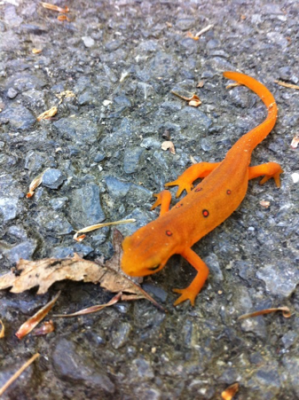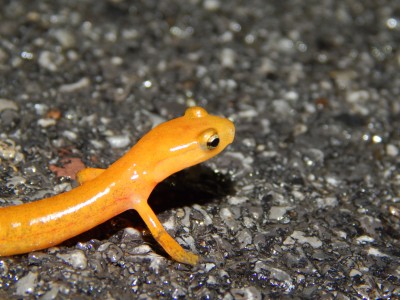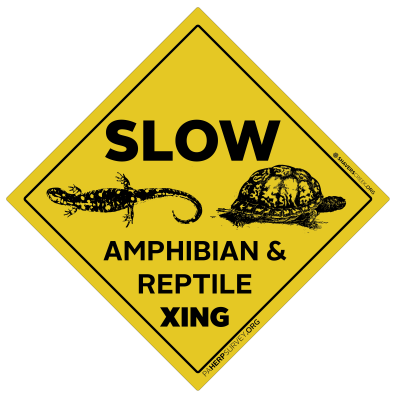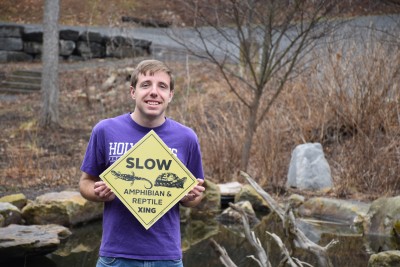It is that time of the year again! Birds are singing, flower buds are starting to form, the days are getting longer and warmer, and amphibians are on the move. Each spring, as the snow melts and the temperatures begin to rise, frogs, toads, newts, and salamanders awake from their hibernation state and migrate to spring pools. While this is an exciting time for us to have an opportunity to view these creatures, but also a dangerous time for them as they seek to avoid predators and potentially deadly interactions with vehicles!
Red eft stage of the Red-spotted Newt at Shavers Creek in September
Similar to reptiles, amphibians must hibernate each winter to avoid colder temperatures that they would not be able to survive through. Amphibians, such as frogs, hibernate in the mud at the bottom of small ponds or lakes. Though they have lungs and breathe oxygen in the air, many amphibians also have specialized skin that allows them to absorb oxygen and expel carbon dioxide, allowing them to survive buried in the mud. Other amphibians, such as toads and salamanders, will hibernate on land in burrows underneath the soil beneath the frost line.
As amphibians emerge from their hibernation in the spring, they begin to search for vernal pools to breed in. Vernal or seasonal pools form each spring as water from snow melts and spring rains fill into depressions throughout the forest. The pools are considered seasonal or temporary since they often will dry up in the summertime. Vernal pools are critical breeding grounds for amphibians — many species of frogs and salamanders will lay their eggs in these pools. These pools offer protection from egg-eating fish and other species that require a permanent aquatic environment.
As amphibians emerge from their winter hibernation each year, they begin their search for these vernal pools. It is during this time of migration when amphibians are at most risk of road collisions. During early spring rains, thousands of amphibians migrate in Stone Valley in search of vernal pools, often crossing roads in order to reach their destination. They are capable of traveling as far as a quarter of a mile in search of their pools. As they cross roads in search of their breeding pools, they are at risk of being hit by cars. Traffic in areas of high amphibian migration can mean a huge loss of frogs, salamanders, and toads in a single night.
We must cherish the incredible diversity of amphibians in the world and in Pennsylvania. With rapidly spreading diseases, the gradual loss of habitat, and the effects of the climate change, the state of the world’s amphibians are at great risk! This spring as we drive on back roads, build our gardens, or hike in the woods, we can make a conscious decision to help our amphibian friends. Here are a few things you can do to help protect our amphibians:
— Avoid driving on back roads during rainy/humid nights
— Drive slower and more carefully on back roads at night
— If you find an amphibian crossing the road, place it across the road in the direction that it is going.
At Shavers Creek we are installing Reptile/Amphibian Crossing Signs to help alert people of the high density of amphibians and reptiles that cross our roads each spring and summer. We hope that by installing these signs we can reduce the number of road deaths that occur on the Stone Valley roads each year.
As you drive on backroads or go on a hike in the woods this spring, keep an eye out for some of our amphibian friends!
Learn more about our amphibian friends at PA HERPS.
Works Cited
“Amphibian Hibernation.” Backyard Nature.net. N.p., n.d. Web. 6 Apr. 2016.
“Amphibian Migrations and Road Crossings.” Department of Environmental Conservation. N.p., n.d. Web. 6 Apr. 2016.
Mann, Katie. “Vernal Pools a Treasure to Protect.” ClearWater Conservancy.org. N.p., n.d. Web. 6 Apr. 2016.




